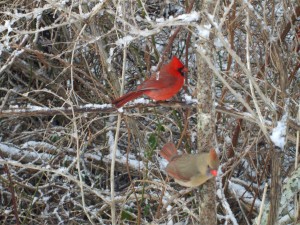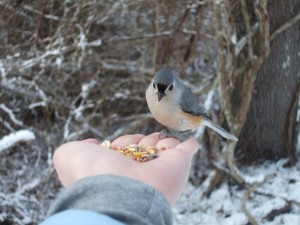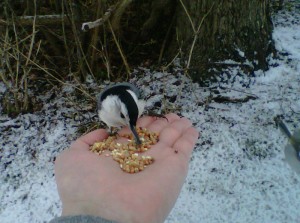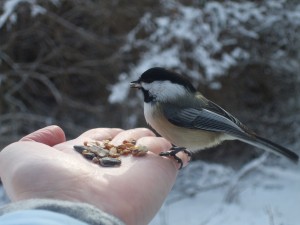Archive for the ‘Long Island’ Category
by Nancy E. Hassel, LIPetPlace.com
Long Island happens to be home to thousands of feral cats – and this winter has been a tough one for many colonies across LI. Many of these cats and kittens are cared daily for by devoted volunteers of rescue groups that try to help deter the problem by trapping them, spay and neutering them and re-releasing them back into the colony their were trapped at. This is also know as Trap-Neuter-Return or TNR. There are exceptions that some younger cats or kittens that are not quite as feral and can be rehabilitated back into living in a home, are giving the chance to be put up for adoption.
Some may wonder where do all these cats come from? Why do we have such a problem with feral cats across our Island? Some contributing factors are people have the false information that cats can fend for themselves and dump cats they no longer want, or were not supposed to own if they were living in an apartment complex or college dormitory. Domesticated cats do not do well when abandoned, and many die from getting diseases that they were not exposed to before, get hit by cars or attacked by other animals. Other factors are people that have or live near a colony of feral cats and just feed them and never ask for help to have them spayed or neutered or know about rescue groups that offer low cost spay and neutering – and as nature would have it, kittens keep coming. I personally remember one house in Lindenhurst while taking my niece and nephew trick or treating a few years ago, there had to be at least 50 cats and kittens living around this house. The word was the owner of the house was feeding the cats continually but not doing anything about the overpopulation. This was in a neighborhood of close quarters and those cats were all over the neighborhood. It was quite sad as the cats were very feral.
Interestingly many of our college campuses have a feral cat problem as well. Stony Brook University actually has a program called SBU Cat Network in which faculty and students volunteer in to help the cats living on the University’s campus. In 2002, Associate Professor of Psychology, Dr. Nancy Franklin founded the program based on Stamford University’s model on how college campuses deal with feral cat colonies. The SBU, is solely dedicated to helping the cats on their campus, and is not an animal shelter. They do offer advice to people and other rescue groups about feral cats, but say that Stony Brook is not a dumping ground for cats, and they cannot take in unwanted cats.
Since the inception of SBU, they have rescued about 350 cats in which half were placed in homes and half were trapped, spay or neutered and released back to their colony. The campus currently has about 30 colonies on the grounds and each colony has an insulated shelter the cats can go into for warmth and to get away from inclement weather. The volunteer students and faculty feed the feral cats 365 days a year and also participate in fundraising for the group and TNR. And as with many other rescue groups raising funds is a challenge in this economy and our currently running in the Shelter Challenge.
Many of the cats that end up as part of a feral colony on the campus are a direct result of some students keep them illegally in dorms and then letting them go when the year is over. As part of the SBU Cat Project outreach, student volunteers do try to educate other students that dumping cats on campus is neither acceptable nor humane – and let them know they are not allowed to keep pets on campus. There are about 25 very active student volunteers in the program, 10 faculty volunteers and many other volunteers throughout the campus. Franklin said, “The University has been very gracious to us while we have been running this program and our volunteer students and faculty members have been wonderful.”
Another organization which serves the towns of Riverhead and Southold is SAVES (Spay, Alter, Vaccinate, Every Stray) a 501 c 3 all volunteer non for profit organization. Like SBU they have no shelter to house cats or kittens, but do have limited foster homes for feral cats that are suitable for homes (that become domesticated). SAVES main focus is TNR, care for the feral cat colonies in both towns – in which there are approximately 40 colonies with a total of about 500 cats. SAVES provides food, winterized shelters, medical attention (besides spaying and neutering) and have volunteers go to feed and check on the colonies daily.
The winterized shelters were originally provided by Shoreham Wading River High School, teacher Dave Driscoll, who and now is at Shoreham Wading River Middle School. Mr. Driscoll wants to work with SAVES to offer humane educational programs, and to help motivate the students to build new shelters. The winterized colonies are now built by a family of SAVES volunteers, but could use additional help in the building process. There are singular shelters and multiple cat shelters made with openings sized for cats to go in and out of, but not big enough for raccoons to get it, the shelters are also up off the ground to help protect the cats from bad weather.
SAVES President Al LaFrance said, “We get about 40 phone calls a week from people who need help with feral cats on their property or looking to re-home cats. We help people living in our territory with TNR, but do not have the resources to help with re-homing.”
SAVES has been going to Kent Animal Shelter for low cost spay and neuter for a while and in 2010 had about 250 spayed and neutered there and had approximately 600 cats spayed and neutered for the entire year about 96 of which were done for free by Helping Paw (a mobile unit) that came to Riverhead to help them. Others were spayed and neutered at the North Folk Animal Hospital and Mattituck Laurel Animal hospital – who they also go to for medical care for the cats.
Their main outlet for adoptions is at the Riverhead Petco in which they house cats and kittens available for adoption through SAVES. Volunteers go Petco 7-days a week 2-times a day to care for them and this past year they have adopted 177 cats. There is an application process that potential adopters must fill out and be approved, as SAVES is looking for permanent homes for their cats with proper care. SAVES is opposed to de-clawing and adopts cats out that will live indoors only.
The focus for them for 2011 is to have more feral cats spayed and neutered by continuing with working with Kent Animal Shelter and their other veterinarian partners, and set up free clinics with Helping Paw. They also plan to offer more humane educations programs and presentations for schools, and boy and girl-scout groups.
So what can you do to help? If you see a feral cat colony that no one is caring for, i.e. no shelter provided, no food or water provided and kittens continually being born, contact a local animal rescue group to let them know about it. (See below for list). If you have feral cats, and are just feeding them, you are very well adding to the problem – reach out to the public animal rescues for help with feral cats in your yard, facility or business.
Another way you can help is by making a monetary donation or donate much needed cat food to help the cats make it through the winter. If you are a cat lover, think about fostering a kitten or two to help them find new homes. Feral cats can very well become the best cat you may ever have had-they don’t all stay in the feral state into which they were born into. I speak from personal experience, taking in a feral kitten from the age of 3-months, who lived a very spoiled 16-years and was a very sweet, smart, funny and dog adoring cat. And yes, her name was “Kitty!”
All About Spay and Neuter – A full service TNR 501 c 3 non-profit all volunteer organization that does 100% TNR servicing Brooklyn, Queens, Nassau and Suffolk. They are not a shelter but can be called for help if you have a feral cat problem in your area. They do about 90 TNR’s a month and since their inception in 2004 have helped just over 5,100 feral cats of which about 850 have been adopted into loving homes.
Kent Animal Shelter – Has low cost spay and neuter.
SAVES Inc. – See above.
by Robyn Elman, President of In Home Pet Services, Inc.
What do Pet Sitters do in a Blizzard?
This has been a rough winter so far with two big storms a rain and ice storm and more snow forecasted to hit our area again. They mayor says to stay off the roads. The schools are all closed and kids get to stay home with their parents or people are away on vacations. So what is a pet sitter to do?
When pet sitters have clients that are away on vacation they, and more importantly their pets, are depending on the sitter to come for their care. Dogs like Sophie the beagle still has to go outside to do her business, get feed, fresh water, love and attention, and cats like Bella needs her daily medications, litter changed, etc.
Dedicated professional pet sitters go with shovels in their cars to each appointment, and if the roads are not plowed they take the train or bus; and if that fails – as in the last blizzard in New York when there was no public transportation – they walked! But pet owners who are hiring pet sitters should also take into consideration the following tips to ensure safety for their pets and their pet sitters:
If you are away during the winter and are relying on a pet sitter, you can make things safer for them, ensuring your pet can get their care.
- Have someone “pre-hired” to shovel in case it snows. Have them shovel your driveway with a path to the road as well as the sidewalk in front of the house, and a path to the door.
- Leave pet safe salt containers for the people shoveling your walk and driveways (with directions to only use that type of salt) – and leave an extra container or two inside incase the pet sitter needs to add additional salt to ice or snow.
- Always have the numbers to your power company and/or heating company displayed for the sitter to call if there is an outage.
- If there is a power outage, or no heat at your home, make sure you have arrangements with your pet sitter so that they can take the dog, cat or bird home with them to board in case of a no heat emergency.
- Extra leashes, collars, dog or cat carrier is great to have available in case the sitter does have to take the pet with them.
- Have the number to the nearest 24-hour vet emergency hospital displayed as well.
- Keep a shovel handy for your sitter to maintain the paths.
- If you have a regularly scheduled dog walker and you are staying home from work – remember to call them to cancel.
- Make sure you have enough pet food, litter, pet medication and bottled water in case you’re stuck and can’t get back on your schedule day due to weather.
Pet Sitters and Dog Walkers truly work through rain, and snow, day and night. Planning ahead during the winter will make the care of your pet a little easier for your sitter to stay safe while caring for your pet. The tips above will make a big difference in the life of your pet and pet sitter during another blizzard.
By Nancy E. Hassel, LIPetPlace.com
There is a magical place on Long Island if you like nature, birds, and seeing wild animals up close and personal, and no it’s not the zoo, game park or sanctuary. A nature preserve on the north shore of the South Fork is one of best places on Long Island to observe nature and have wild birds actually land in your hand. The Elizabeth A. Morton National Wildlife Refuge is a treasure that many Long Islanders have either never heard of or have yet to visit. It’s beautiful in every season, but something magical happens when there is a fresh fallen snow. Maybe it’s the fact that there are less people there and more wildlife walking around. The birds are always very active, but in the winter they are amazing. You will never see so many bright red cardinals in one place at one time, and for some Long Islander’s you will see birds you have never seen before at your back yard feeder.
If you are looking for something to do outside with your now cabin fevered up kids, or maybe your kids have never been this close to nature, Morton’s is definitely worth the trip whether you live 5 minutes away or an hour away. There is no other place that I know of like it. On any given day your can see families of deer walking around, wild turkeys who are not the least bit scared of you, bunnies, squirrels, red tailed hawks, and of course the birds: chickadees, nut hatches, blue jays, tons of cardinals, sparrows and many other species, who will literally greet you at the entrance. It’s quite a spectacle.
The first time I ever went, I was with family members and it was a freezing cold day in February of 2006, we had no idea what the place was or that we would be bombarded by birds, and followed through the trails by them. It was really funny. At one point we turned around and there had to be at least 30 red (male) cardinals in on tree.
There is a trail that leads down to the bay beach, (maybe a mile long), and there is a look out deck equipped with binoculars and the view is spectacular. Another part of the trail loops around through the woods and you pass and pond with a deck for observing wildlife, and you will also cross over a few short wooden foot bridges. The variety of the landscape at Morton’s is quite interesting too, from wooded trails, tall pine trees, to a swampy feel near the pond to a magnificent bay beach – there is something to see around every turn.
If you have never been, or have only visited in the summer, you may just want to pack up the kids in their winter gear and head out for a day trip. This place will not disappoint – and wouldn’t it be nice to get those kids off of the video games for a day?
This is a nature preserve so there are rules, like no pets allowed, not even your little cute dog – leave him home. No bicycles, and please don’t liter or take things out of the park.
Directions and all info can be found here. More photo’s below.
Slide show here:
Into: Nancy E. Hassel, LIPetPlace.com
Story by Pamela Fitzpatrick, of YourDogWalkers, shihtzu58@optonline.net
Wednesday, January 5, 2011 is National Bird Day celebrating the diverse species of parrotheads, macaws, parakeets, and wild birds alike. Seasoned birders and novices will learn about conservation, dangers affecting wild parrots and health care for pet birds and birds at your back yard feeders. An interesting species of mini parrots called parrotlets, is brought to light by Pamela Fitzpatrick, read below about these cuties:
“I recently had lunch with a friend, who has several parrotlets. I’ve always loved birds, but didn’t know much about these beautiful little guys. Turns out these mini parrots make great pets, all the benefits of a parrot without the larger size.
Parrotlets (“little parrot”) are very small parrots that are native to South and Central America. In the wild, they travel in flocks of up to 100 birds. With their striking colors, this must be an awesome sight!
Like lovebirds, they are very social, and can form strong pair bonds in the absence of human companionship. For this reason, they are often kept as pairs. You can keep a single parrotlet happy however, by spending lots of time with it and giving it exercise and mental stimulation. (For that matter, providing a fun and entertaining cage environment helps keep any kind of pet bird pet busy when you aren’t around).
Like the better well known cockatiel, parrotlets are intelligent and curious with speaking and whistling capabilities. Some learn to talk, while others never will. As a general rule, males are more talkative than females. In addition to mimicking tunes and sounds, they can learn a vocabulary of 10-15 words.
The most common species of parrolet are the Pacific (Celestial) or GreenRump. Birds of both genders are mostly green, while the males have gorgeous blue markings.
If you’ve been thinking about adding a parrot to your family, maybe these smaller versions are right for you! They are easy to care for, and require a lot less room than their larger parrot cousins. With proper care, they can live 10-15 years. For more information, check out the international parrolet society at www.internationalparrotletsociety.org.”
by Nancy E. Hassel, LIPetPlace.com
Is your dog BORED?
Long Island is now covered with a lot of snow and while most of our dogs love it – they all can’t stay out too long in it. The weather and shorter days changes all of our routines, and often our dogs don’t get the long walks they need to drain that mental and physical energy. So if you think your dog is bored or getting a serious case of cabin fever, here are a few fun tips that can’t help break up the monotony of the long cold winter.
• Dogs love to play “hide-n-go seek.” Now I know what you’re thinking, it seems silly, but they love it. Also it helps with training dogs to “sit and stay.” (And if you have kids, they love it too!) Here is how you do it: Teach your dog to sit and stay, and go hide in a somewhat obvious spot so the dog can find you. Call the dog, and when he finds you, make a big fuss, “Good boy, great job!” Do this a few times in easy spots for the dog to find you, so he gets the hang of the game. Then make him sit and stay, and go hide in a different spot (a little more difficult for him to find you this time) and call him. This fun exercise will help the dog in training, it will challenge him mentally, and most of all add exercise and fun to his day, and yours.
• Another fun game is the “find it” game. This can be done a few different ways, but the easiest is to take a few treats, break them into smaller treats (or use a handful of kibble) and have your dog sit and stay. Put a couple treats about 6-feet in front of him, but in plain site and say, “Buddy, find it,” and point to the treats. When he trots over to eat them, tell him, “Good job, good find it!” Then continue to do this making the treats further away, and not so obvious. Dogs get the hang of this pretty quickly, and love this game too. You can make it harder by having the dog sit and stay in another room, and hide the treats throughout the house. Just be sure to deduct the kibble or treats from what you normally feed the dog. You don’t want to make the dog overweight!
• Take him or her to a training class or agility class. Some training centers have indoor facilities like, Doggie U K9 Academy in Bay Shore, or the new Fido Fitness Club in Woodmere. You can also set up an indoor play date with your dog’s best pal in your home, just make sure it’s doggy proofed and safe for them to play.
• There are now also board games you can play with your family and your dog. DARF Inc. offers various different games to keep your family and the dog entertained and interactive. www.darfinc.com
• Watching too much TV while snowed in? Use the commercial breaks to do short and fun training sessions with your dog.
• And of course one of our favorites are Kong toys, which can keep a dog entertained for quite a while. Your dog should be supervised with any toy, same goes for the Kong. Try stuffing it with a few pieces of kibble that fall out easily and one larger biscuit that will take longer for Fido to get to. Kongs come in all shapes and sizes, and different levels of toughness from: Puppy, Classic, Senior and Extreme. Be sure to get the right size and level for your chewer, and always supervise. www.kongcompany.com.


















Categories
Archives
Blogroll
Meta